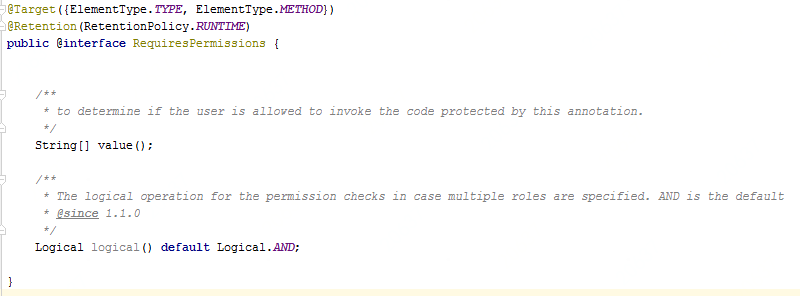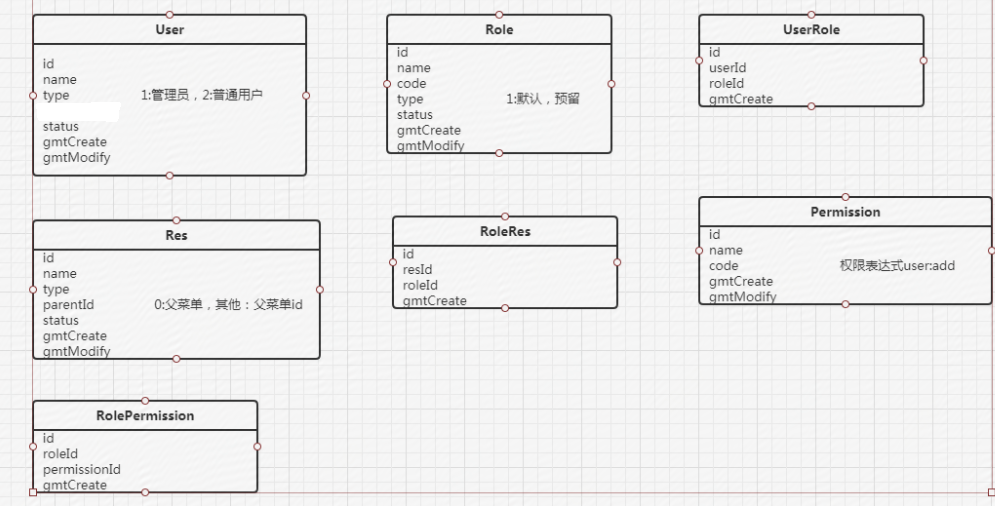在我们的web开发过程中,经常需要用到功能权限校验,验证用户是否有某个角色或者权限,目前有很多框架,如Shiro
Shiro有基于自定义登录界面的版本,也有基于CAS登录的版本,目前我们的系统是基于CAS单点登录,各个公司的单点登录机制略有差异,和Shiro CAS的标准单点登录校验方式也自然略有不同。
在尝试将自定义登录的普通版Shiro改造失败后,在系统登录、校验角色、权限我认为相对简单后,觉得模仿Shiro自己实现一个权限校验小框架,说是框架,其实就是一个aop advisor,几个注解(Shiro不就是这个功能吗)


RequiresRoles和RequiresPermissions相似,不截图了
接下来是实现aop拦截功能了,先来说下注解的用法,和Shiro的注解一样,都是放在class或者method上

上述配置的意思是需要角色user和admin,需要权限home:*,上面仅是一个例子,实际业务中的角色已经确定有哪些权限了。

以下是aop拦截方式
/**
* 权限校验advisor,负责对RequiresRoles、RequiresPermissions标记的controller进行权限校验
* 他执行的时机是interceptor之后、方法执行之前
* Created by Administrator on 2015/2/9.
*/
@Aspect
@Component
public class AuthExecuteAdvisor implements PointcutAdvisor, Pointcut {
private static final Logger logger = LoggerFactory.getLogger(AuthExecuteAdvisor.class);
@Autowired
private UserService userService;
/**
* 生成一个始终匹配class的Filter对象,任何类都可以通过这个过滤器
*/
private static final ClassFilter TrueClassFilter = new ClassFilter() {
@Override
public boolean matches(Class<?> clazz) {
return true;
}
};
/**
* 生成根据特定注解进行过滤的方法匹配器
* 如果class上有注解、或方法上有注解、或接口方法上有注解,都能通过
*/
private MethodMatcher annotationMethodMatcher = new StaticMethodMatcher() {
@Override
public boolean matches(Method method, Class<?> targetClass) {
if (targetClass.isAnnotationPresent(RequiresRoles.class) || targetClass.isAnnotationPresent(RequiresPermissions.class)) {
return true;
}
if (method.isAnnotationPresent(RequiresRoles.class) || method.isAnnotationPresent(RequiresPermissions.class)) {
return true;
}
// The method may be on an interface, so let's check on the target class as well.
Method specificMethod = AopUtils.getMostSpecificMethod(method, targetClass);
return (specificMethod != method && (specificMethod.isAnnotationPresent(RequiresRoles.class)
|| specificMethod.isAnnotationPresent(RequiresPermissions.class)));
}
};
@Override
public ClassFilter getClassFilter() {
//只执行注解的类
return TrueClassFilter;
}
@Override
public MethodMatcher getMethodMatcher() {
return annotationMethodMatcher;
}
/**
* 当前对象就是切面对象,根据classFilter、MethodFilter定义执行范围
*
* @return
*/
@Override
public Pointcut getPointcut() {
return this;
}
/**
* 切面对应的处理策略
*
* @return
*/
@Override
public Advice getAdvice() {
//这个MethodInterceptor相当于MethodBeforeAdvice
return new MethodInterceptor() {
@Override
public Object invoke(MethodInvocation invocation) throws Throwable {
LoginContext loginContext = ActionContext.getLoginContext();
if (loginContext == null) {
throw new AuthFailException("校验用户权限失败,用户未登录");
}
// TODO: 2017/11/21 管理员全权限
if (loginContext.getUserType().equals(0)) {
return invocation.proceed();
}
Set<String> alreadyRoles = new HashSet<>(userService.getRolesByUserId(loginContext.getUserId()));
Set<String> alreadyPermissions = new HashSet<>(userService.getPermissionByUserId(loginContext.getUserId()));
List<String> requireRole = getRequiredRole(invocation);
List<String> requirePermission = getRequiredPermission(invocation);
if (!CollectionUtils.isEmpty(requireRole) && !alreadyRoles.containsAll(requireRole)) {
//role权限不足
logger.error("校验用户权限失败,role角色不足");
throw new AuthFailException("校验用户权限失败,role角色不足");
}
if (!CollectionUtils.isEmpty(requirePermission) && !alreadyPermissions.containsAll(requirePermission)) {
//permission不足
logger.error("校验用户权限失败,permission权限不足");
throw new AuthFailException("校验用户权限失败,权限不足");
}
return invocation.proceed();
}
};
}
/**
* 获取方法需要的角色
*
* @param invocation
* @return
*/
private List<String> getRequiredRole(MethodInvocation invocation) {
List<String> requiredRoles = new ArrayList<>();
Class<?> clazz = invocation.getThis().getClass();
if (clazz.isAnnotationPresent(RequiresRoles.class)) {
Collections.addAll(requiredRoles, clazz.getAnnotation(RequiresRoles.class).value());
}
if (invocation.getMethod().isAnnotationPresent(RequiresRoles.class)) {
Collections.addAll(requiredRoles, invocation.getMethod().getAnnotation(RequiresRoles.class).value());
}
return requiredRoles;
}
/**
* 获取方法需要的权限
*
* @param invocation
* @return
*/
private List<String> getRequiredPermission(MethodInvocation invocation) {
List<String> requirePermission = new ArrayList<>();
Class<?> clazz = invocation.getThis().getClass();
if (clazz.isAnnotationPresent(RequiresPermissions.class)) {
Collections.addAll(requirePermission, clazz.getAnnotation(RequiresPermissions.class).value());
}
if (invocation.getMethod().isAnnotationPresent(RequiresPermissions.class)) {
Collections.addAll(requirePermission, invocation.getMethod().getAnnotation(RequiresPermissions.class).value());
}
return requirePermission;
}
/**
* 每个切面的通知一个实例,或可分享的实例
* 此处使用分享的实例即可,分享的实例在内存中只会创建一个Advice对象
*
* @return
*/
@Override
public boolean isPerInstance() {
return false;
}
}
此处主要有以下几个关键点:
当前类既是一个切入点Pointcut(一群方法),也是一个通知持有者Advisor Pointcut接口通过ClassFilter、MethodMatcher锁定哪些方法会用到Advisor Advisor接口通过getAdvice获取Pointcut需要进行的拦截操作
ClassFilter是一个始终返回True的类过滤器,因为我们拦截执行的最小单位是method,所以即使class上没有注解,也要让他通过拦截 MethodMatcher则会判断method所在的class是否有注解,如果没有,则判断method是否有注解,二者满足其一就能通过校验 Advice的具体拦截过程为: 获取登录上下文 获取当前method需要的权限和角色(这里实际可以再优化,因为method可能只需要Role或Permission其中一种权限) 判断当前用户是否具有这些权限
开启spring的aop功能,权限拦截开始生效